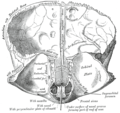Arachnoid granulation
Arachnoid granulations (also known as Pacchionian granulations) are small protrusions of the arachnoid mater (the middle layer of the meninges) into the outer membrane of the dura mater. They protrude into the venous sinuses of the brain, and allow cerebrospinal fluid (CSF) to exit the subarachnoid space and enter the blood stream.
Structure[edit]
Arachnoid granulations are composed of clusters of arachnoid cells. They are located in the dura mater, the outermost of the three layers of the meninges. The granulations are most commonly found in the superior sagittal sinus, one of the venous sinuses of the brain, but can also be found in other dural sinuses.
Function[edit]
The primary function of arachnoid granulations is the reabsorption of cerebrospinal fluid (CSF) from the subarachnoid space into the venous system. This is a crucial process in the circulation of CSF, maintaining a balance between the amount of CSF produced and the amount absorbed.
Clinical significance[edit]
Arachnoid granulations can become enlarged or hypertrophic in certain conditions, such as idiopathic intracranial hypertension. This can lead to the formation of arachnoid cysts, which can cause symptoms such as headaches, seizures, and visual disturbances.
See also[edit]
References[edit]
<references />
|
|
|
Arachnoid_granulation[edit]
-
Diagram of the brain showing arachnoid granulations
-
Close-up of arachnoid granulations
-
Illustration of the brain with arachnoid granulations
-
Anatomical drawing of arachnoid granulations
-
CT scan of a pacchionian body in the transverse plane
-
CT image showing Pacchioni granulation
Ad. Transform your life with W8MD's Budget GLP-1 injections from $75


W8MD offers a medical weight loss program to lose weight in Philadelphia. Our physician-supervised medical weight loss provides:
- Weight loss injections in NYC (generic and brand names):
- Zepbound / Mounjaro, Wegovy / Ozempic, Saxenda
- Most insurances accepted or discounted self-pay rates. We will obtain insurance prior authorizations if needed.
- Generic GLP1 weight loss injections from $75 for the starting dose.
- Also offer prescription weight loss medications including Phentermine, Qsymia, Diethylpropion, Contrave etc.
NYC weight loss doctor appointmentsNYC weight loss doctor appointments
Start your NYC weight loss journey today at our NYC medical weight loss and Philadelphia medical weight loss clinics.
- Call 718-946-5500 to lose weight in NYC or for medical weight loss in Philadelphia 215-676-2334.
- Tags:NYC medical weight loss, Philadelphia lose weight Zepbound NYC, Budget GLP1 weight loss injections, Wegovy Philadelphia, Wegovy NYC, Philadelphia medical weight loss, Brookly weight loss and Wegovy NYC
|
WikiMD's Wellness Encyclopedia |
| Let Food Be Thy Medicine Medicine Thy Food - Hippocrates |
Medical Disclaimer: WikiMD is not a substitute for professional medical advice. The information on WikiMD is provided as an information resource only, may be incorrect, outdated or misleading, and is not to be used or relied on for any diagnostic or treatment purposes. Please consult your health care provider before making any healthcare decisions or for guidance about a specific medical condition. WikiMD expressly disclaims responsibility, and shall have no liability, for any damages, loss, injury, or liability whatsoever suffered as a result of your reliance on the information contained in this site. By visiting this site you agree to the foregoing terms and conditions, which may from time to time be changed or supplemented by WikiMD. If you do not agree to the foregoing terms and conditions, you should not enter or use this site. See full disclaimer.
Credits:Most images are courtesy of Wikimedia commons, and templates, categories Wikipedia, licensed under CC BY SA or similar.
Translate this page: - East Asian
中文,
日本,
한국어,
South Asian
हिन्दी,
தமிழ்,
తెలుగు,
Urdu,
ಕನ್ನಡ,
Southeast Asian
Indonesian,
Vietnamese,
Thai,
မြန်မာဘာသာ,
বাংলা
European
español,
Deutsch,
français,
Greek,
português do Brasil,
polski,
română,
русский,
Nederlands,
norsk,
svenska,
suomi,
Italian
Middle Eastern & African
عربى,
Turkish,
Persian,
Hebrew,
Afrikaans,
isiZulu,
Kiswahili,
Other
Bulgarian,
Hungarian,
Czech,
Swedish,
മലയാളം,
मराठी,
ਪੰਜਾਬੀ,
ગુજરાતી,
Portuguese,
Ukrainian








